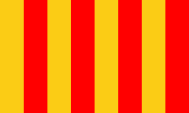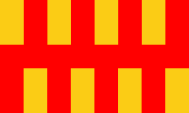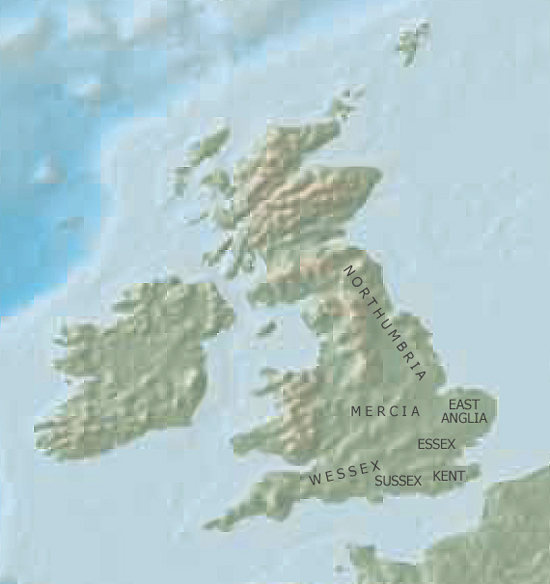mobile View, to the German Version tap the flag


- Northumbria
- former Kingdom in Northern England
- own name: Norþhymbra Rīce
• Introduction
• History
• Flag
• Meaning/Origin of the Flag
• Map
• Origin of the country's Name
Britannia was conquered by Roman legions around the year 43 and became in 85 a province of the Roman Empire. Towards the end of the fourth century the Roman Empire came under considerable pressure from outside, so that Britannia could no longer be held. Thus the Romans began to withdraw about 400 or 410. Shortly afterwards, Jutes and Angles began to migrate in eastern and southern Britannia coming from today's Denmark and Saxons coming from the area of the Weser and Elbe estuaries, and also some Frisians. The differences between the peoples blurred over the generations, and they were summarized under the term Anglo-Saxons. As fighters they have been very welcome for the mostly Romanesque Celtic British, against the since the withdraw of the Romans advancing Picts and Scots. Already in the middle of the fifth century, they had established themselves as the new aristocracy and began to separate from themselves by the formation of their own kingdoms.
Since the beginning of the 6th century, seven great kings have been known which dominated the south and east of Britannia. A formation of states that has become known in history as "Heptarchy" (Greek: hepta = seven). These have been the kingdoms of Sussex, Wessex, Essex, Kent, East Anglia, Mercia and Northumbria. However, in reality, there have been more and some smaller kingdoms, which, however, often existed for only a short time. In 825 Wessex, Sussex, Kent and Mercia became united under King Egbert of Wessex. Essex, East Anglia and parts of Mercia were occupied by invading Danes in the year 865 and became summarized as "Danelaw" (Danelag, territory of Danish law). In 1016 the Danish Knut the Great (brother of the king of Denmark) forced his election to the first king of England. After riots the Danish rule ended in 1050, and in 1066 Harald II., Earl of Wessex, was crowned to the first Anglo-Saxon King of England.
Source: Wikipedia (D)

In the 6th century, Angles from today's Denmark migrated into Northern England. The kingdom of Northumbria was formed by the unification of the kingdoms of Bernicia and Deira, which was carried out several times between 604 and 679, and it fell again and again into the sub-kingdoms. The final unification succeeded in 679 under King Ecgfrith. In the meantime, however, the Celtic-British kingdoms of Elmet, Craven and Dent were annexed, and a sphere of influence was established far to Scotland. With the neighboring kingdom of Mercia there were tensions, which culminated in the Battle of Dunnichen Mere in 685, in which the King of Northumbria died. The power of Northumbria fell apart and the country sank into civil wars and throne disputes. From the end of the 8th to the middle of the 9th century, Vikings and Danes frequently invaded and annexed the south of the country (Deira) to their Danelag and installed in the north (Bernicia) a Viceroy, which was overthrown in 878. His successor tried to restore the kingdom of Northumbria and attacked Deira. He was, however, pushed back, and in 878 the Vikings and Danes completely conquered Bernicia. In the period from 920 to 954, the Vikings and Danes were expelled by troops of the kingdom of Wessex, and Northumbria was restored, but as a county of the kingdom of Wessex. It remained controversial between England and Scotland, and was finfally given to England in 1237 by the Treaty of York. Today Northumbria consists of the counties of Northumberland and Durham.
Source: Wikipedia (D)


Flag of Northumbria,
ratio = 3:5,
Source, by: Wikipedia (FR)






Flag of Northumberland,
ratio = 3:5,
Source, by: Wikipedia (FR)






The time of the Heptarchy belongs – in the themes of flags or coats of arms – to the period of protoheraldics. This means that seals, coats of arms or flags, as we know them today, were not yet in use. Nevertheless, it seems that there was a kind of symbolism, which is partly handed down, or it is known from the field of legends. The coats of arms or flags were designed in the modern age, which are used now for the ancient kingdoms of the Heptarchy.
The heraldry of Northumbria, which is known today, seems to be not authentic. The today known flag, ten times vertically divided between yellow and red, should go back to the Kingdom of Bernicia. The flag of the today's County of Northumberland is reminiscent to this flag. The colors could go back to those of Scotland.
Source: Wikipedia (EN), Wikipedia (FR), Volker Preuß


Source: Freeware, University of Texas Libraries, modyfied by: Volker Preuß

The name of the country describes its location northern the river Humber. The word stem of Humber refers to the Latin word "umbra", which means shadow and probably indicates the coloring of the water.
Source: Wikipedia (D)


![]()










